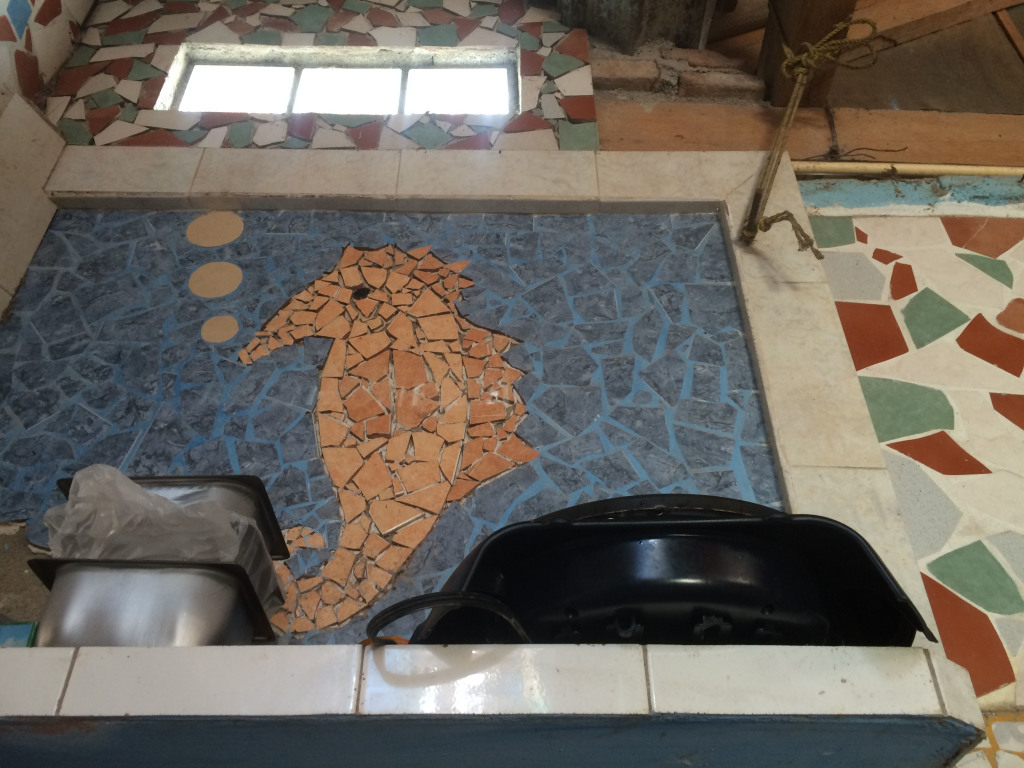My week-long solo adventure began with an easy, short bus ride to Melaque. When I finally found where to catch the next bus to La Manzanilla, I discovered I had just missed one and had to wait over an hour and a half for the next one. I wouldn’t have minded wandering around Melaque a bit if I didn’t have my heavy pack with me. Instead I went a few blocks to one of the best ice cream places in Mexico (that we’d visited a few days before). I had the opportunity to tell the girl it was the best ice cream I’ve had in Mexico and she “whoo hooo’d” and clapped, and as I was leaving she told her father what I’d said (well, she told him I said it was the best ice cream in “todo el mundo” – world…close enough). It was clearly a family operation and they were proud of their homemade ice cream – so I was glad I got to tell them how good it was (and grateful I could do so in Spanish!).
I met a Canadian woman while I was waiting for the bus and found out she and her ex-husband had boat and had wanted to cruise. They got invited to cruise for six weeks on a Swan 56 (huge, gorgeous boat) and she said that trip pretty much blew their plans for cruising. They discovered it was not all hammocks and cocktails…it was far more work than they had imagined and they nixed the idea altogether. The next short bus ride was a bit of an adventure. I’m not sure exactly what was wrong with the bus, but it seemed to be popping out of gear a lot and making a horrible grinding noise. I was in the front seat with a large space in front of me, where plastic jugs of fuel and a large metal tool box were sliding around on the floor. Around the sharp, steep corners, while bracing myself I also tried to hold the tool box and fuel jugs with my leg so they wouldn’t slide around and hurt someone. The man next to me had a little boy sleeping on his lap, and he and I exchanged a few laughing cringes and I wished I knew how to say “if you can’t find ‘em, grind ‘em” in Spanish. One of the American women sitting behind me started nervously yelling “I don’t like this! I think we should get off! I’m taking a taxi next time. Shouldn’t we get off???” I looked out the window at the woods and views from the mountain we were going over and thought, “get off and do what?!”. So in an effort to calm her down, and thinking of much scarier rides I’d had, I just said “Hey, at least we can’t see the road through the floor”. It didn’t seem to appease her.
I made it to La Manzanilla just fine and found the house I was staying at. The school had led me to believe I was staying with a family, as in being part of the family, in the family home – like an exchange student type situation—where I’m the only person staying with them and they are interested in having me. As it turned out, I was staying in a room, more similar to a hostel situation – where there are other renters with different agendas, and the family had a private residence next door that I never even got to see.
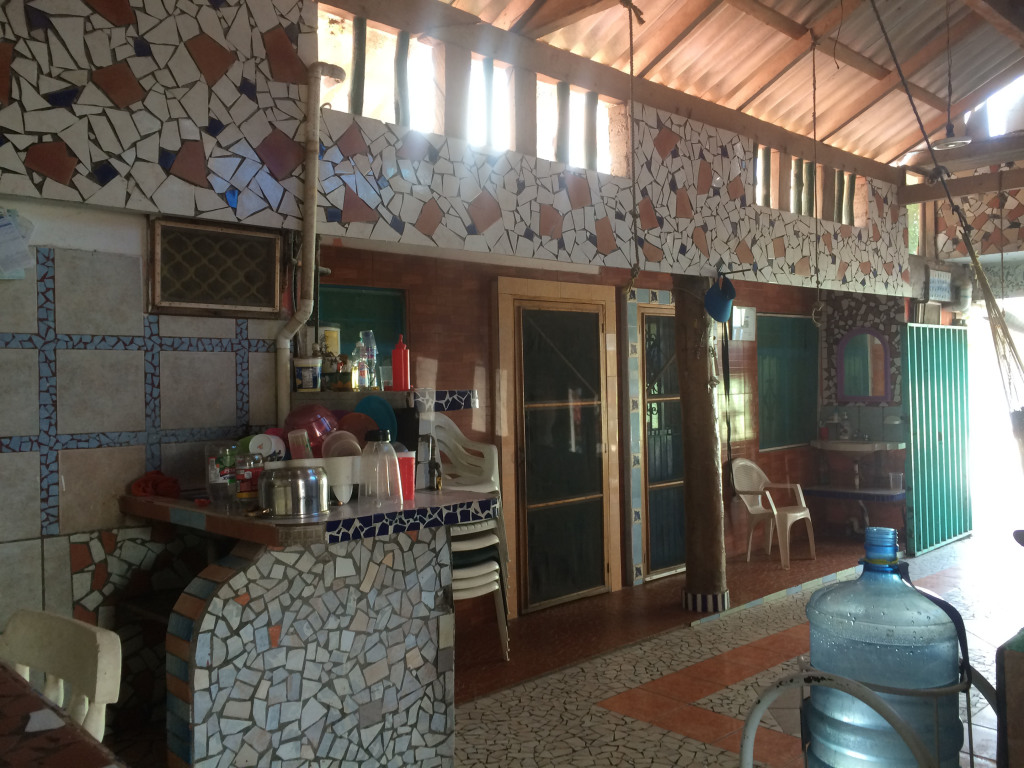
When I paid my deposit online, I had also chosen the “no meals” plan, as it seemed ridiculously expensive and I was sure I could either work something out to share costs with the family or simply eat on my own. They wanted $40 for a week of breakfasts – and we spend less than $40 for 3 meals / day for 2 people all week. I just couldn’t do it. The only reason I was in school at all was that I had saved my parents’ gifts for the last two birthdays and Christmases – so this week was a generous gift from my parents and I certainly wasn’t going to let it be a rip-off! But the school was insisting that it was necessary for me to pay this for some reason I couldn’t understand. They said I could switch the breakfast to a dinner if that was better for me.

At the “homestay”, I was shown my room, which was huge and had a double bed and a single bed, and my own toilet and shower and a very large fan. I certainly couldn’t complain about that!! I briefly met Chayo and Andres and their daughter Jenny. Chayo spoke to me in rapid Spanish and seemed kind of annoyed with me (either because I wasn’t understanding everything or I’m just annoying in general, I’m not sure) and then they all disappeared. I met Jan, the wonderful Canadian woman in the room next to mine, and she showed me the ropes of the place – there was a refrigerator on the rooftop terrace I could put some food in, and during the week Chayo ran a taco stand from the front of the place and used the kitchen facilities (which consisted of a 2 burner cook top) for that. As it turned out, Jan was good friends with the mother of Peter – the guy we’d met on Fukngivr! Always a small world.
I briefly met Chayo and Andres and their daughter Jenny. Chayo spoke to me in rapid Spanish and seemed kind of annoyed with me (either because I wasn’t understanding everything or I’m just annoying in general, I’m not sure) and then they all disappeared. I met Jan, the wonderful Canadian woman in the room next to mine, and she showed me the ropes of the place – there was a refrigerator on the rooftop terrace I could put some food in, and during the week Chayo ran a taco stand from the front of the place and used the kitchen facilities (which consisted of a 2 burner cook top) for that. As it turned out, Jan was good friends with the mother of Peter – the guy we’d met on Fukngivr! Always a small world.

My accommodations were surrounded in beautiful tile work – tile work is Andres’ trade and he did the whole place himself. I had fun noticing new designs everytime I looked around.
There I was alone and it didn’t appear there was a dining area where I was going to be sharing meals with the whole family, and no one was around to offer me a meal. I figured I’d sort it all out on Monday morning when I could actually talk to the people at the school in person. Since I was starving, I wandered into the town square and had some delicious and cheap tacos and beans (if I had those every night for dinner it would cost me $12 for the week). I chatted with a lovely Canadian couple on vacation and then wandered over to the flan booth for a nice slice of choco-flan in the plaza. It was a lively night at the square, which was only a block from my place. I stopped at a tienda and purchased breakfast food- yogurt, honey, granola and juice to last me all week (for just over $6) and stuck it in the rooftop fridge. I unpacked and settled in a bit in the room, feeling a little unsure of the whole situation I found myself in. I had dreams of ending the week with a whole new family, surrounded with people who wanted nothing more than to patiently share themselves with me while I struggled to speak and understand.

I was feeling a strange mix of excitement and nervousness for my classes, and mixed feelings about the housing situation. On the one hand, it was certainly my kind of place to stay as a budget traveler, on the other hand it was not at all what I was led to believe I was paying so much money for. I learned from Jan that I didn’t even want to know how much she was paying for an identical room – as it was so much less than what I was paying to the school for accommodations.
I found a bowl, spoon and cup for my breakfast in the morning, and rather than eat on the rooftop alone, I brought my food downstairs in hopes of someone being around. I did get to chat a bit with Chayo and tried to understand the whole meal and payment situation. We discovered that Chayo gets less than half of what I had paid to the school and almost nothing for meals if she needs to provide them. I told her I would rather give the money directly to her – buy tacos from her taco stand etc. She seemed to be fine with that and didn’t have a problem with me storing my breakfast food and using her bowls and utensils. I started to get the sense that this school might be a bit of a rip off. This was later confirmed by a number of other people’s stories.
I went in a bit early to meet the office manager and figure out this whole $40 debacle (determined not to pay it!) and then have my first 3 hour class session. Miriam in the office was a very sweet woman who had been so helpful to me in all the emails leading up to my arrival, was extremely nice and seemed to understand my plight. She told me not to pay the rest of my fees until she talked to the bosses. I went up to my classroom on the third floor with breathtaking views of the town and La Manzanilla Bay dotted with picturesque sailboats. There I met Miguel, who, as it turns out was to be my private instructor for the week.

I guess there were no other intermediate students signed up for that week! Instead of 3 hours, we covered the same materials in 2 hours each day (as per the school’s policy). I was not surprised or upset by this – although I was a bit disappointed not to meet new classmates to study with, I was also quite happy to be getting 100% of the teacher’s attention. Again, another weird mix of feelings about the whole thing. I absolutely loved Miguel, though, no mixed feeling there! He was the perfect wise and patient teacher-figure, and never once laughed at me (inappropriately, anyway). He did once call me a liar, though. He would read articles to me in Spanish and I would have to tell him in my own words (again, in Spanish) what it was about. I only had the vaguest notion about this one article, so I was kind of making stuff up, using words I knew… he started laughing heartily and said “Mentirosa!” (liar!).
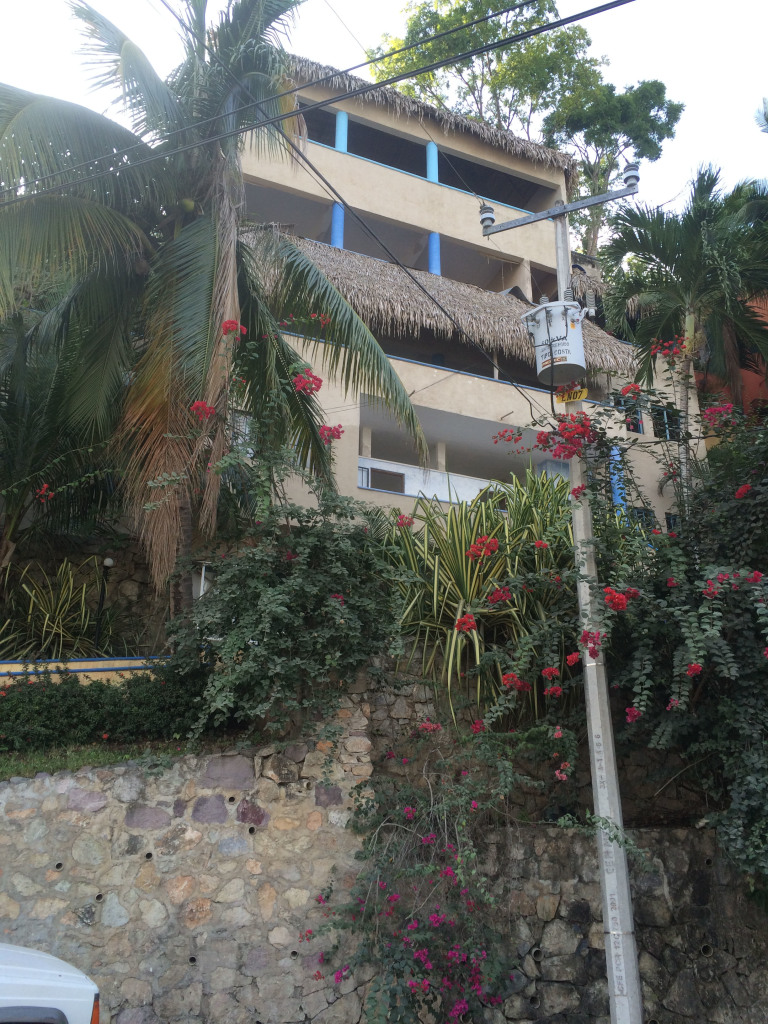

The class time was well structured with a great booklet of past, present and future tense conversations and articles, and every day I had to write a diary and answer true/false and essay questions about a long article. I was very happy with all of that and feel like I made some great progress. The thing I am the worst at is listening for comprehension. If I can read it, no problems at all, but I did struggle every time he said “Escucharme!” (listen to me). I realized I was nearly illiterate and I’d been speaking horribly wrong Spanish for so long, with no one correcting me, that some things had to be unlearned with much difficulty. I want to start wearing a sign around my neck that says “Por favor, corrija mi español” (Please correct my Spanish). Everyday Miguel would correct my diary and I had to re-write it all correctly for the next day. We also got into a number of off topic conversations, which were great, and I so appreciated him stopping to correct me as I rambled on and on. If you’ve been reading my blogs, you know how badly I ramble on and on in English, I’m sure you can imagine how patient Miguel must be to suffer through my stilted ramblings in Spanish!
As it turned out there were no extracurricular activities planned or available to me- as the school’s website had led me to believe. I was on my own to force my way into the family life and find other people in town to talk to. Not too hard for someone like me, right? Except for the fact that the town was crawling with white folk, mostly Canadian and many not speaking a lick of Spanish. Being as I am, I was a prime target for people to come up to me and start speaking English (I don’t know why, but I’m the person people always stop to ask for help and directions, etc). The locals were clearly kind of sick of tourists and all very busy working hard. I couldn’t seem to worm my way into any lazy chit-chat with townfolk. This was not going to be the “immersion” week I’d hoped for. Maybe if I’d had 3 or 4 weeks I could start penetrating some inner circles, but for now I was just another gringa.
I did manage to work out the $40 situation. The bosses (who, I discovered, were actually money-grubbing Americans) said that if I weren’t eating any food, they would generously knock the bill down to $20 for the use of Chayo’s plates. I simply refused and Miriam sighed heavily and amended my final invoice to be $40 less. I never got to meet these bosses who were trying to charge American prices for Mexican services (or in some cases, NO services), and I’m actually glad about that. My only regret was that I didn’t choose the ‘no lodging’ option and be able to pay Chayo what she deserved directly. It was a learning experience in more ways than language.
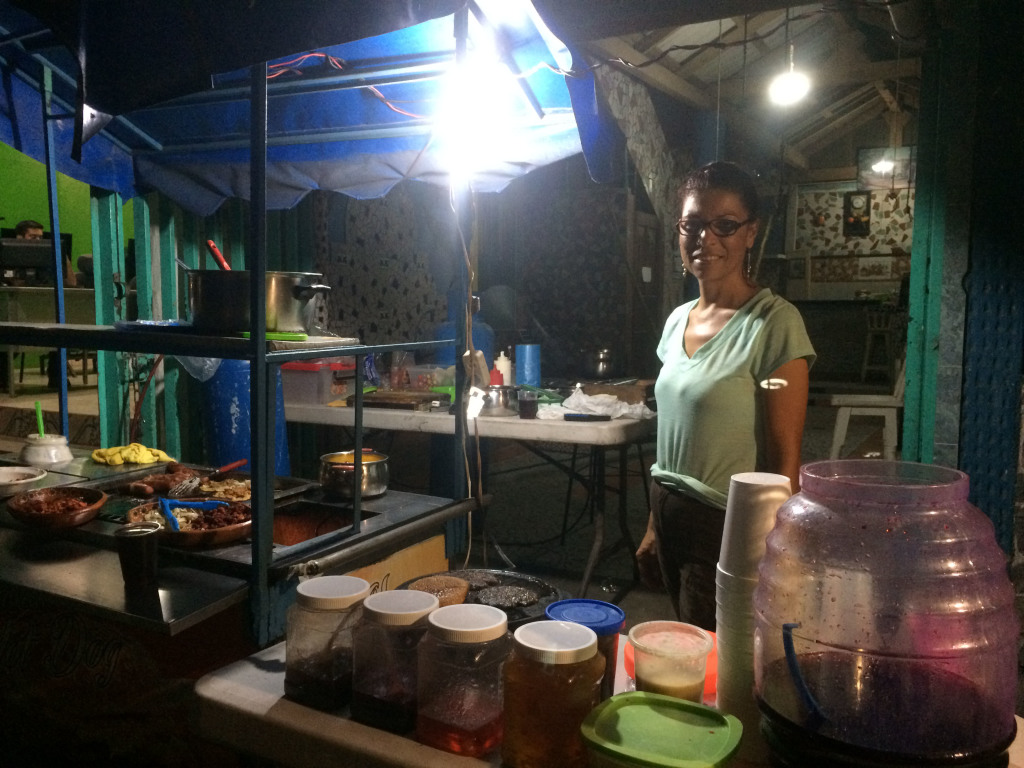

It was feeling strange to be on my own, as well as on land. So much space, and so many places and things and noises and no endless tasks or chores. It was all a bit overwhelming and I felt a little lost. I wasn’t there to site-see or shop and playing on the beach was not a big draw. So I spent most of my afternoons working on my homework, availing myself of the luxury of wifi and enjoying a daily shower. There were a number of people coming and going and for a couple days I wasn’t even sure how many people were living there. I finally sorted it all out – Bonnie and Charley were the awesome folks in the upstairs apartment and aside from Jan, all the other folks were just visiting friends. A lot of great people to meet and chat with and I was unable to resist speaking English. I generally don’t get enough socializing in any language, so I was eating it up!
I observed how different land-people are from boat-people. Everyone we meet on other boats are always instantly our new friends, we easily invite each other on board and chat for ages. Land people are much more reserved and it’s a lot harder to break in. I guess cruisers are all pretty much ‘in the same boat’ and on the same page with most things – where as there are so many different situations or possibilities for what’s going on with land based lives- that people are a little more wary others and protective of themselves. It was an interesting thing to note, and also made me feel a little lonely. I was so grateful to for the time I got to spend chatting and hanging out with my new friends!
One afternoon Jan had bought some shrimp and invited me to help her prepare a shrimp feast. We sautéed them with onions, garlic, ginger, and coconut and pineapple – absolutely delicious on-the-fly recipe that I can’t wait to try again. Jan made a big pot of rice and we had a (for me) second lunch. Chayo joined us and we got to practice a bit more Spanish.

Another day, as I passed by the building that housed the municipal jail, there was a gorgeous little German shepherd puppy tied up in the courtyard. He was still there on my way back and I couldn’t resist stopping in to say hi.  An older man came out and sat with me and patiently conversed. He was in no hurry and happy to chat – finally – someone else to practice my Spanish with! I learned the puppy had been found wandering alone and they were hoping to find his owners. I offered to take pictures to put up on the La Manzanilla webpage (that has a posting board where all the ex-pats gossip). My new conversation-friend Lorenzo asked me if I liked cerveza. Sure, I’ve got nothing against cerveza. Then he wanted to go get a cerveza with me. I figured he just wanted to knock back a beer with someone after work (he said he worked there at the jail building as the #2 guy in charge). We went to the nearby tienda and he motioned for me to pick out one of the giant beers from the cold case (he had a mangled arm, so it was hard for him to get it). I guess we were splitting it? He insisted on paying and we walked slowly to the park by the beach with our beer and plastic cup. As it turns out, Lorenzo doesn’t drink, and he wanted ME to drink that entire beer.
An older man came out and sat with me and patiently conversed. He was in no hurry and happy to chat – finally – someone else to practice my Spanish with! I learned the puppy had been found wandering alone and they were hoping to find his owners. I offered to take pictures to put up on the La Manzanilla webpage (that has a posting board where all the ex-pats gossip). My new conversation-friend Lorenzo asked me if I liked cerveza. Sure, I’ve got nothing against cerveza. Then he wanted to go get a cerveza with me. I figured he just wanted to knock back a beer with someone after work (he said he worked there at the jail building as the #2 guy in charge). We went to the nearby tienda and he motioned for me to pick out one of the giant beers from the cold case (he had a mangled arm, so it was hard for him to get it). I guess we were splitting it? He insisted on paying and we walked slowly to the park by the beach with our beer and plastic cup. As it turns out, Lorenzo doesn’t drink, and he wanted ME to drink that entire beer.
Suddenly, a light bulb went off in a dusty, unused corner of my brain…this seemingly sweet old guy with one gnarled, useless hand and a debilitating limp, was trying to get me drunk. I certainly hadn’t expected that. I sipped politely as Lorenzo tried to nail me down for a dinner date the next night. I had a very busy schedule with my new friends, so of course I couldn’t commit to anything… I felt bad, as Lorenzo was clearly just a lonely old man, but he was sort of an annoying, lonely old man. I tried to leave him with the nearly-full giant bottle of lousy beer, but he insisted I take it with me when I hurried off to my evening plans. I had to spend the next few days trying to avoid him every time I walked through town.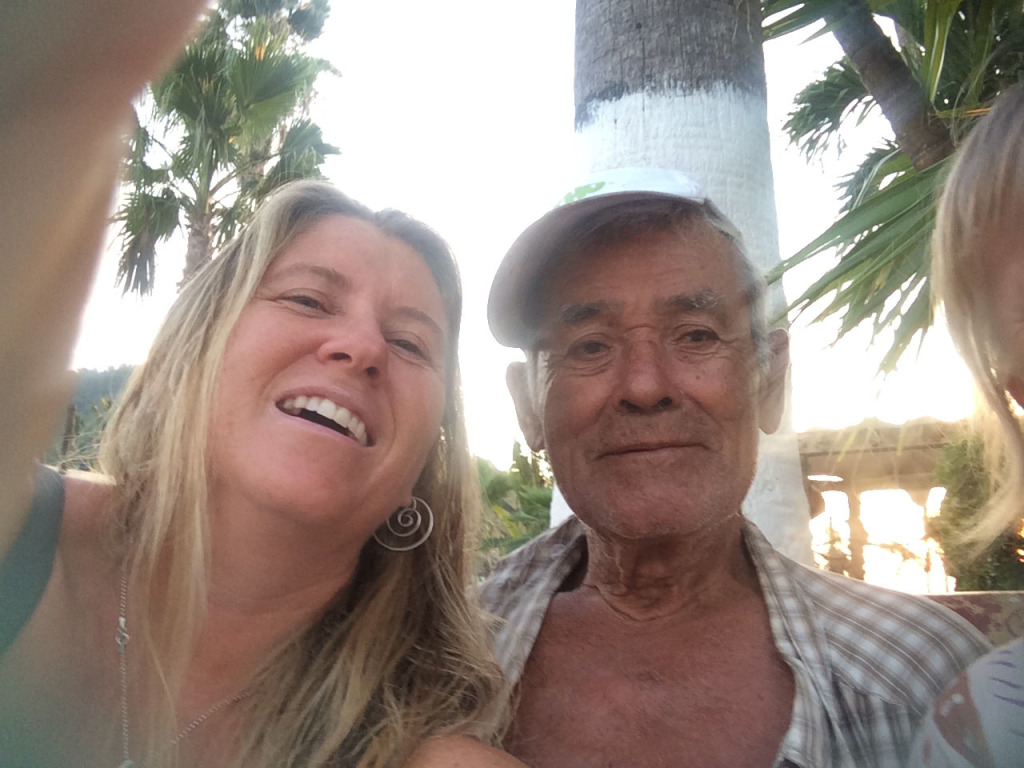
That evening, I actually DID have plans – I had a date with myself to attend the showing of an award-winning Mexican movie. I figured it would be good to watch a movie in Spanish as part of my learning. I didn’t even know what it was about or what the place that was showing it was all about. But it was just a block behind Chayo’s place. It turned out to be, well, actually I still don’t know what it was. It was just called Casa Luz. I thought it might be like a restaurant or at least a place that sold drinks. But it was at the top floor of a palapa type house and it was just an open space lined with plastic chairs and a pull down screen. As it turned out Miriam from the school office was sort of spearheading this event. She actually graduated from film school in Guadalajara and was in the midst of making her first film. It was nearly finished, but they badly needed funding – this evening’s film was a fundraiser for Miriam’s film. She showed a trailer and fund-asking clip. Hopefully the room full of wealthy-looking white folk was able to help her out (keep an eye out for her movie – Los Años Azules (The Blue Years)). The movie I ended up seeing was called “The Amazing Catfish”. Thankfully it had subtitles, but it was good for me to try to understand and hear words I knew. It was kind of depressing – about a lonely young woman who gets involved with a mother of four who is dying of AIDs. At the end, I ducked out right after the credits, before the lights came on and everyone saw me crying. I went home to write a summary of the film for my Spanish journal homework.
My final class came all too quickly. I wrote a card for Miguel (I’m sure he’s dying to correct it and return it to me, but I’m hoping it was all right!) and brought him a fresh cinnamon bun (I had no idea what else to do, but I wanted to bring him something to show my appreciation). I was really surprised that he also gave ME a gift when we were saying goodbye. I certainly hadn’t expected that – it was very sweet! It was a cute little purse that says “Morelia” on it, which is a town more inland. I was very touched that he did that.
I had a few good nights sitting out at the table on the street by Chayo’s taco stand. Listening to people’s conversations (even understanding some) and meeting a few people now and then. By Friday night, Jenny, Chayo’s 11 year old daughter, warmed up to me a bit when I brought out the Bucky Balls. They are a little cube of curiously strong magnetic balls that you can do all kinds of things with. We played with them for a couple hours – and it was great to see her doing something other than playing with her phone. I couldn’t resist giving them to her when we were finished. She was surprised and extremely excited –she said “gracias” many times. On Saturday – no school for any of us! I tried to do a little computer work and Jenny came in and hung out with me. We played with the Bucky Balls, listened to music and she drew me an adorable picture of us as mermaids under the sea. She helped correct me when I said things that clearly sounded stupid, but when she said things I didn’t understand it was sometimes frustrating for her. I found that I had learned enough to realize how badly I had been speaking before. Because of that, I lost a little confidence and was getting far shyer in speaking to people. I used to just blunder along saying everything I could think if, often making up words, until I knew I was understood. As Miguel told me, I need to practice, practice, practice!

Bonnie and Charley kindly invited to take Jan and I out for the best pozole in Mexico on my last night. I could hardly believe it was already my last night. I was really just getting to know everyone and was wishing I had one more week. Prior to dinner, Jan and I went up to see their friends Beth and Murray, who were staying in a beautiful little place up on the hill. We saw a wedding going on as we passed by the church and hiked up the hill to the fancier part of town. We had a great visit, enjoying the sweeping views of the town and bay, along with snacks and margaritas, before heading down for our pozole-fest.

I’d not yet tried pozole, so I was excited for the excuse to do so. We waited for the pop up street restaurant to complete set up and eagerly anticipated our meals. It got crowded fast and we ended up sharing our table with three other folks as our food was coming out. It turned out to be the nice couple I had met on my first night in town and one of their friends! It was great seeing them (they met me when I was feeling unsure of everything and finally got the “how it all turned out” happy ending story) and everyone had a good time chatting with everyone. The square was lively that night, with a loud band and a few food carts around. Charley and Bonnie treated us to a huge piece of tres leches cake and flan. We went back to the homestead to share our treats and play a fun word game (Bananagrams). We really need more games on the boat! (or, rather, any games).
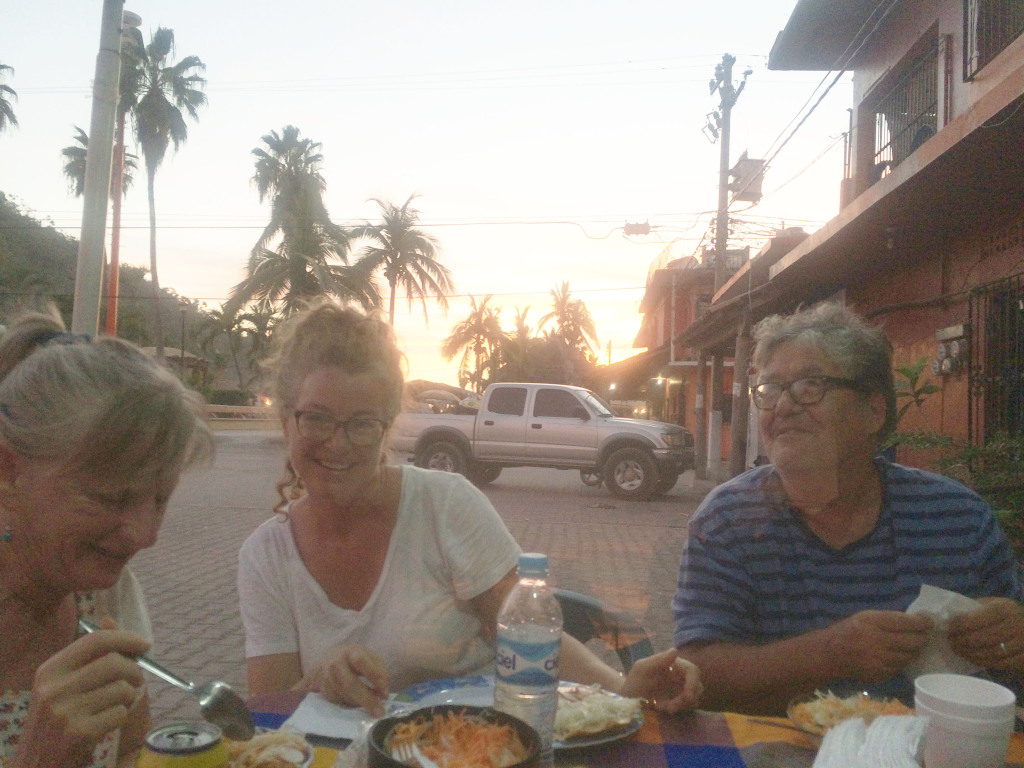
While I was looking forward to being back to the comforts of my own home and cooking, I really wished I had a more time with these wonderful folks. But the next morning I was packed up and waiting for the bus. Andres and his sister in law were heading to Melaque and Chayo got them to take me (and Jan – who wanted to come along for the ride) all the way to Barra de Navidad! Saving me 2 bus rides – it was a quick trip, and good to listen to more Spanish conversation along the way. Everyone came out to wave goodbye and I was happy to have met all these great folks and hoping we keep in touch and maybe even get to visit again. Jan and I took the water taxi out to the lagoon – she was thinking of stopping to see Peter, but I think she changed her mind.
I was glad to get back home and change into some comfier clothes – a week of wearing real-people clothes was a bit much! I filled Jonny in on all my adventures and heard about his quiet week. He proudly declared that he didn’t speak to anyone all week, except for while he was surfing. To each his own, I guess!! Going away is great, but I was so grateful for the cool breezes and peace and quiet as I fell into my cushy memory foam that night. How much longer will we stay in Barra? Good question and one that will be answered someday. At least by the next blog post, I imagine!





